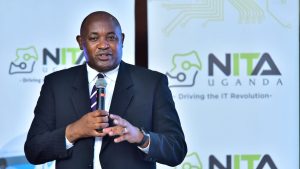Share
According to Uganda Registration Services Bureau registrar general Mercy Kainobwisho, it is equally crucial to protect these rights against unauthorized use by others as it is to promote innovation both domestically and abroad.
“We are all aware that business nowadays is driven by technology. The Intellectual Property Automation System (IPAS), which WIPO [World Intellectual Property Organization] implemented in Uganda in 2009, has been crucial in helping IP offices like ours use technology for data management and registration, according to Kainobwisho.
She said this when discussing the value of digital transformation for intellectual property offices during the 64th series of Assemblies of Member States of WIPO Meetings, which will take place from July 6–14, 2023. The conferences were held in Geneva, Switzerland, at the WIPO headquarters.
According to Kainobwisho, it is more important than ever to safeguard intellectual property rights in light of the proliferation of technology platforms that tolerate covert infringement.
According to Kainobwisho, the development and continuous evolution of information and communications technology has made skills and knowledge the primary source of long-term sustainable competitive advantage.
Intellectual property is essential for emerging nations like Uganda to achieve economic success, she continued.
The adoption and use of technology to efficiently preserve and enforce IP rights is now being promoted by URSB, the national IP office for Uganda, because these practices are essential to fostering innovation and economic development.
IPRs are protected, and new technology are discussed.
According to Kainobwisho, the emergence of new technologies, such as websites that permit the downloading of music, books, and movies, has created new potential forms of intellectual property rights and presents a new challenge for enforcing some IP rights, necessitating the consideration of novel strategies for the efficient protection of IP rights.

The URSB’s current Industrial Property Administration System (IPAS) has aided in streamlining and automating a number of procedures relating to the registration, management, and upkeep of intellectual property assets. Patents, utility models, trademarks, industrial designs, and geographical indications are only a few of the intellectual property rights that are covered by the IPAS. IPAS has not yet been sufficiently integrated with copyright. Modalities to have a strong copyright protection system are being considered. Additionally, she informed the audience that the URSB recently built the Front Office with assistance from the European Union Intellectual Property Office (EUIPO), enabling the submission of applications electronically and enabling the automatic classification of industrial designs and trademarks.
The Industrial Property Administration System (IPAS) that the URSB currently employs has assisted in streamlining and automating a number of procedures relating to the registration, management, and upkeep of intellectual property assets. The IPAS includes a variety of IP rights, including as patents, utility models, trademarks, industrial designs, and geographical indications. IPAS does not yet sufficiently incorporate copyright. Modalities are being thought of in order to have a strong copyright protection system. The Front Office, which enables electronic application submission and permits automatic classification of industrial designs and trademarks, was also recently introduced by URSB with assistance from the European Union Intellectual Property Office (EUIPO), she informed the audience.
Taking advantage of safety
She claimed that the URSB’s mission on IP registration has given comfort to inventors, industrial designers, and creative artists that their rights will be properly secured thanks to the help of partners.
The protection of IP rights has improved as a result of efforts made by numerous parties, including capacity-building programs, technical assistance, training, and exchanging best practices.












